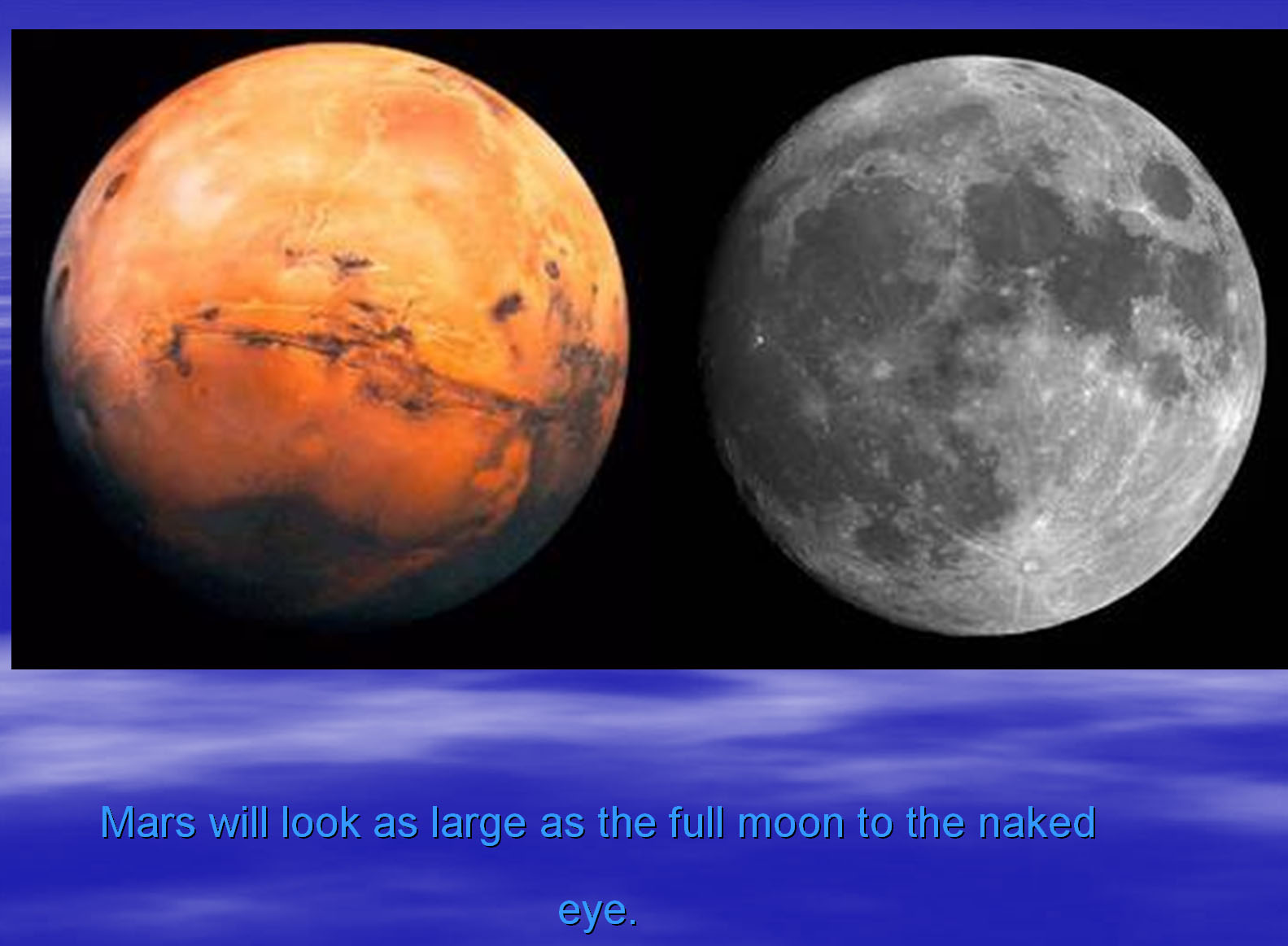
Planète Mars et la Lune
Depuis 27 août 2003, l'année où la planète Mars a été
le plus proche de la Terre, des canulars sur Internet ont circulés à l'effet que
Mars serait pratiquement la grosseur de la Lune. Comme de raison c'est une
grande fausseté. Voici quelque document explicatif sur le sujet.
Article dans Wikipédia
|
Rapprochements remarquables [modifier] Le 27 août 2003 à 9 heures, 51 minutes et 14 secondes UTC, est atteinte la plus grande proximité depuis 59 618 ans entre Mars et la Terre. La distance Terre-Mars est alors de 55,758 millions de kilomètres[130]. Cet évènement a suscité une rumeur selon laquelle Mars apparaîtrait « aussi grosse » que la Lune. Mais avec un diamètre apparent de 25,13 secondes d'arc, Mars apparaissait tel un point dans le ciel, alors que la Lune formait un disque d'un diamètre apparent d'environ 30 minutes d'arc. Des analyses détaillées du portrait gravitationnel du système solaire permettent de prévoir un rapprochement (très légèrement) plus étroit le 28 août 2287, à 55,688 millions de km. |
| Source: http://fr.wikipedia.org/wiki/Mars_(plan%C3%A8te) juillet 2010 |
Page publiée par la NASA sur le sujet.
| Beware the Mars Hoax Earth and Mars are converging for a
close encounter--but not as close as some people think. July 7, 2005: Just when you thought it was safe to read your email.... There's a rumor about Mars going around the internet. Here are some snippets from a widely-circulated email message: "The Red Planet is about to be spectacular." "Earth is catching up with Mars [for] the closest approach between the two planets in recorded history." "On August 27th … Mars will look as large as the full moon." And finally, "NO ONE ALIVE TODAY WILL EVER SEE THIS AGAIN." Only the first sentence is true. The Red Planet is about to be spectacular. The rest is a hoax. Here are the facts: Earth and Mars are converging for a close encounter this year on October 30th at 0319 Universal Time. Distance: 69 million kilometers. To the unaided eye, Mars will look like a bright red star, a pinprick of light, certainly not as wide as the full Moon. Sign up for EXPRESS SCIENCE NEWS delivery Disappointed? Don't be. If Mars did come close enough to rival the Moon, its gravity would alter Earth's orbit and raise terrible tides. Sixty-nine million km is good. At that distance, Mars shines brighter than anything else in the sky except the Sun, the Moon and Venus. The visual magnitude of Mars on Oct. 30, 2005, will be -2.3. Even inattentive sky watchers will notice it, rising at sundown and soaring overhead at midnight. You might remember another encounter with Mars, about two years ago, on August 27, 2003. That was the closest in recorded history, by a whisker, and millions of people watched as the distance between Mars and Earth shrunk to 56 million km. This October's encounter, at 69 million km, is similar. To casual observers, Mars will seem about as bright and beautiful in 2005 as it was in 2003. Although closest approach is still months away, Mars is already conspicuous in the early morning. Before the sun comes up, it's the brightest object in the eastern sky, really eye-catching. If you have a telescope, even a small one, point it at Mars. You can see the bright icy South Polar Cap and strange dark markings on the planet's surface. |
| Source: http://science.nasa.gov/science-news/science-at-nasa/2005/07jul_marshoax/ juillet 2010 |
| Mon courriel 27 juillet 2006 |
Exemple d'image accompagnant le canular. Voici deux exemples de canulars qui sont transmis en format PPS.

![]()
Au besoin Cliques ici pour m'envoyer un courriel.
Dernière modification : 11 janvier 2017.